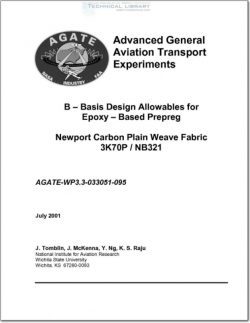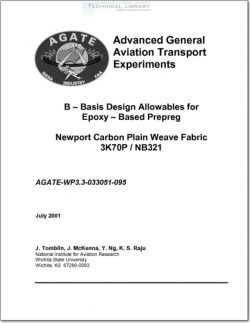AGATE-WP3.3-033051-095

- Version
- 315 Downloads
- 7.97 MB File Size
- 1 File Count
- August 8, 2016 Create Date
- August 8, 2016 Last Updated
B-Basis Design Allowables for Epoxy Based Prepreg - Newport Carbon Plain Weave Fabric 3K70P-NB321

The Advanced General Aviation Transport Experiments (AGATE) consortium is an
industry-university—government partnership initiated by NASA to create the technological
basis for revitalization of the United States general aviation industry. It was founded in
1994 to develop affordable new technology as well as the industrial standards and
certification methods for composite airframe, cockpit, flight systems and airspace
infrastructure for Federal Aviation Regulations (FAR) Part 23 aircraft. The composite
material properties contained within the document were generated under Work Package
3 : Integrated Design and Manufacturing Methods.
Although AGATE was focused towards the small general aviation aircraft (Part 23), the
test methods and results contained in this document are consistent with MlL-HDBK-17-
1E,2D,3E - Military Handbook for Polymer Matrix Composites. All material, specimens,
fixtures and test results contained within this document were traceable and conformed by
the Federal Aviation Administration (FAA) as part of the AGATE effort. It should be noted
that before application of the basis values presented in this document to design,
demonstration of the ability to consistently produce equivalent material properties as that
evaluated during this program should be substantiated through an acceptable test
program.
The test methods and results described in this document are intended to provide basic
composite properties essential to most methods of analysis. These properties are
considered to provide the initial base of the “building block” approach. Additional coupon
level tests and subelement tests may be required to fully substantiate the full-scale
design.
It is common to see small fluctuations in an unfitted plot of the weight gain vs. time curve.
There were no fluctuations that made significant errors in results or caused rejection in
the moisture equilibrium criteria. Once the traveler coupons passed the criteria for two
consecutive readings, the samples were removed from the environmental chamber and
placed in a sealed bag with a moist paper or cotton towel for a maximum of 14 days until
mechanical testing. Strain gauged specimens were removed from the controlled
environment for a maximum of 2 hours for application of gages in ambient laboratory
conditions.
| File | Action |
|---|---|
| AGATE-WP3.3-033051-095 B-Basis Design Allowables for Epoxy Based Prepreg - Newport Carbon Plain Weave Fabric 3K70P-NB321.pdf | Download |
Comment On This Post